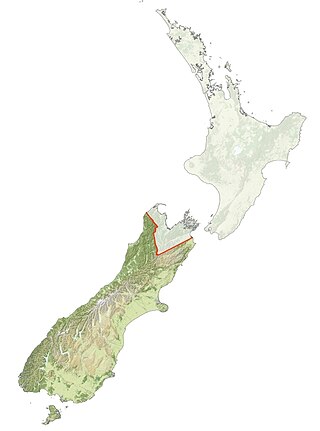Related Research Articles
Māori, or te reo Māori, commonly shortened to te reo, is an Eastern Polynesian language spoken by the Māori people, the indigenous population of mainland New Zealand. Closely related to Cook Islands Māori, Tuamotuan, and Tahitian, it gained recognition as one of New Zealand's official languages in 1987. The number of speakers of the language has declined sharply since 1945, but a Māori-language revitalisation effort has slowed the decline.
Iwi are the largest social units in New Zealand Māori society. In Māori iwi roughly means "people" or "nation", and is often translated as "tribe", or "a confederation of tribes". The word is both singular and plural in the Māori language, and is typically pluralised as such in English.

Lake Wānaka is New Zealand's fourth-largest lake and the seat of the town of Wānaka in the Otago region. The lake is 278 meters above sea level, covers 192 km2 (74 sq mi), and is more than 300 m (980 ft) deep.

Ngāi Tahu, or Kāi Tahu, is the principal Māori iwi (tribe) of the South Island. Its takiwā is the largest in New Zealand, and extends from the White Bluffs / Te Parinui o Whiti, Mount Mahanga and Kahurangi Point in the north to Stewart Island / Rakiura in the south. The takiwā comprises 18 rūnanga corresponding to traditional settlements. According to the 2018 census an estimated 74,082 people affiliated with the Kāi Tahu iwi.

Lake Hāwea is New Zealand's ninth largest lake.

Orokonui Ecosanctuary, called Te Korowai o Mihiwaka in Māori, is an ecological island wildlife reserve developed by the Otago Natural History Trust in the Orokonui Valley between Waitati and Pūrākaunui, New Zealand, 20 kilometres (12 mi) to the north of central Dunedin.

Ngāi Tāmanuhiri is a Māori iwi of New Zealand and were formerly known by the name of Ngai Tahu, and Ngai Tahu-po respectively. They are descendants of Tahu-nui who is also the eponymous ancestor of the Kai Tahu iwi of Te Waipounamu.

Kura kaupapa Māori are Māori-language immersion schools in New Zealand, where the philosophy and practice reflect Māori cultural values with the aim of revitalising Māori language, knowledge and culture. Kura kaupapa Māori are established under the Education Act (1989). The term kaupapa Māori is used by Māori to mean any particular plan of action created by Māori to express Māori aspirations, values and principles.

Clifford Hamilton Whiting was a New Zealand artist, teacher and advocate for Māori heritage.
Mount Grey is a 934-metre (3,065 ft) mountain 15 kilometres west of Amberley in New Zealand. It is named after Sir George Grey who was governor of New Zealand when English surveyors climbed it in 1849. In Te Reo Māori, the mountain is Maukatere, "floating mountain", from where the spirits of the dead leave on the long journey to Cape Reinga.

Te Whakaruruhau o Ngā Reo Irirangi Māori is a New Zealand radio network consisting of radio stations that serve the country's indigenous Māori population. Most stations receive contestable government funding from Te Māngai Pāho, the Māori Broadcast Funding Agency, to operate on behalf of affiliated iwi (tribes) or hapū (sub-tribes). Under their funding agreement, the stations must produce programmes in the Māori language, and must actively promote Māori culture.
Tania M. Ka'ai, sometimes known as Tania Kaai-Oldman, is a New Zealand education academic. She is of Ngāti Porou, Ngāi Tahu, Native Hawaiian, Cook Island Māori, and Sāmoan descent and is a full professor of language revitalisation at the Auckland University of Technology.
Barbara Jane Anderson is a New Zealand ecologist.
Mere Whaanga is a New Zealand writer, illustrator, historian, researcher and academic whose work includes bilingual picture books, history books and conference papers. Several of her books have been shortlisted for or won awards and she herself has received a number of awards, grants, fellowships and writing residencies. She lives in Māhia, Hawke's Bay.
Hana Merenea O'Regan is a Māori language advocate and academic in New Zealand. She is a member of the Ngāi Tahu iwi (tribe).

Pūrākaunui is a small settlement in Otago, in the South Island of New Zealand. It is located within the bounds of the city of Dunedin, in a rural coastal area some 25 km to the north of the city centre.
Louise Magdalene Teowaina Wallscott was a Māori activist, teacher and weaver.

Rānui Ngārimu is a New Zealand Māori weaver and textile artist. She affiliates with Ngāi Tahu and Ngāti Mutungā iwi.
Ross Calman is a New Zealand Māori writer, editor, historian, and translator of the Māori language.
References
- 1 2 "Ahi Pepe MothNet – Aotearoa - Curious Minds, He Hihiri i te Mahara". Curious Minds, He Hihiri i te Mahara. 2017-05-12. Retrieved 2018-02-14.
- ↑ "About Ahi Pepe | MothNet". www.landcareresearch.co.nz. Retrieved 2018-02-14.
- ↑ Anderson, Barbara (3 April 2017). "A whisper of moths". Otago Daily Times. Retrieved 2018-02-14.
- 1 2 New Zealand Ministry of Education (26 October 2017). "Embracing our cultural richness: Ahi Pepe | MothNet project | Education Gazette - Education in New Zealand". Education Gazette. Retrieved 2018-02-14.